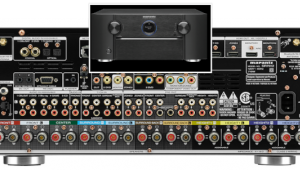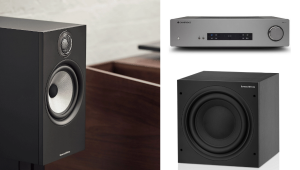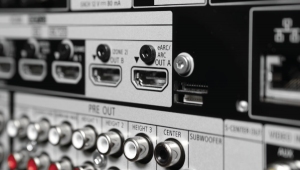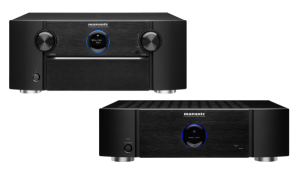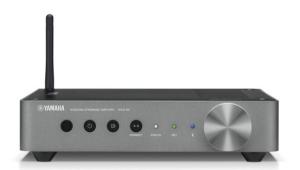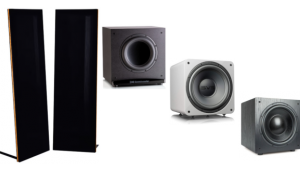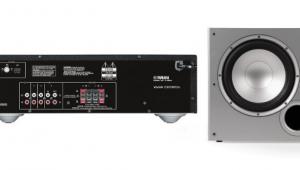Older AVR, Surround Placement, Audiophile Debate

My father-in-law had a home-theater system installed a couple of years ago and would like to add a Blu-ray player. He asked me to hook it up, but I'm running into a problem with his system. The receiver is a Yamaha RX-V659, which only has component-video switching. I want to avoid running a separate HDMI cable to the TV and having him switch sources on the TV and receiver separately. Will connecting a Blu-ray player via component video cause the player to downconvert copy-protected disks to 480i? Do the majority of Blu-ray titles have HDCP?
Rusty Richards
I agree that having to switch both the TV and AVR is a pain, though this problem can be mitigated by a good universal remote, such as the Logitech Harmony One. Most Blu-ray players will send no more than 1080i via component, but they won't downconvert Blu-rays to 480i, even with HDCP, which is found on virtually all commercial discs. Even so, sending 1080i via component won't produce the best possible picture, since the content on most Blu-rays is encoded at 1080p, so the player must interlace it and the TV must then deinterlace it, probably resulting in artifacts.
Also, your father-in-law won't get the full benefit of the new audio formats without HDMI unless the Blu-ray player has multichannel analog-audio outputs connected to the AVR's multichannel analog-audio inputs, which requires six or eight cables just for audio.
The best solution is to get a new AVR with HDMI switching, but short of that, I would probably send HDMI to the TV and multichannel analog audio to the receiver and switch both using a universal remote. If you connect the player's component output to the AVR, he'll still see high-def, but the image could well have visible artifacts.
You're Surrounded!
I have seen many websites (including Dolby's and THX's) dictate where the surround speakers should be placed laterally, but few provide any guidance about where they should be placed height-wise. Should the tweeters be placed at ear height, or should they be above one's head? If they are above one's head, should they be tilted down to the main seating positions? I'm using B&W 685s as my surround speakers.
Gonzlobo
According to THX, direct-radiating surround speakers such as yours should be mounted fairly high up on the wall (maybe six feet above the ground) just behind the listening position and pointed at each other, not at the listener, in order to create a diffuse, enveloping surround soundfield with movie soundtracks. Dipole/bipole side-surround speakers should be mounted a couple of feet above seated ear height with the null region pointed toward the listener.
Endless Debate
I know this subject was endlessly debated a decade or so back, but for the benefit of those of us who have only recently come to home theater and "more than iPod" audio, is it possible to get audiophile quality stereo out of a home theater setup?
I'm not talking about the extremes—clearly, there is equipment at the far end of the audio rainbow that exceeds anything in home theater. My question is aimed at the moderate and budget listener. Could I take, say, five PSB Alpha B1s, marry 'em to an Onkyo or Denon receiver, get decent home theater performance and still be able to enjoy pure stereo?
Scott Atkinson
I'm sure the audiophile community would still say that high-quality 2-channel performance is not possible with a home-theater system, and I agree that the two types of systems are optimized for different tasks and thus cannot serve the other task optimally. But enjoyment is in the ear of the beholder. I'm happy listening to 2-channel material on my home-theater system (PSB speakers, Pioneer AVR). Does it sound as good as a megabucks 2-channel rig? Of course not, but given the amount of 2-channel listening I do (not much), my system is perfectly adequate for me. Only you can decide if you can be happy under those conditions.
Long-time audiophile Tom Norton has this to say about the subject:
I don't agree that it's impossible for a single system to serve both tasks, but to do so, you must build the system carefully. For example, a set of high-end 2-channel speakers will not make the best system for movies if the center-channel speaker provided by the manufacturer does not match the tonal quality of the left and right, as is often the case. A modest A/V receiver might provide a great home-theater experience, but it cannot match the audio quality of the best separate preamp and power amp. A surround pre/pro might not match the sound of the best 2-channel preamp, but you can get around this by using a great preamp between the pre/pro and power amps. Use the 2-channel preamp directly with 2-channel sources and run the left and right signals from the surround pre/pro through it for movies, using a known fixed setting in the preamp or choosing a preamp with a fixed gain/bypass mode specifically designed for this purpose.
If you have a home-theater question, please send it to scott.wilkinson@sorc.com.
